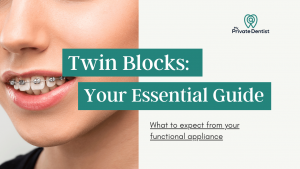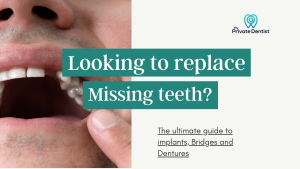Braces are becoming increasingly popular amongst teens and adults, and it can be confusing to know which type of brace you should go for. As a dentist who does braces, I often get asked: Which type of brace is best for me? Each type has pros and cons, which I have detailed below to help people decide.
What are the different types of braces?
There are 5 main types of braces available to straighten your teeth. These are:
- Metal braces
- Ceramic braces
- Self-Ligating braces
- Lingual braces
- Clear Aligner Systems (eg. Invisalign)
Metal Braces
Traditional metal braces are the most common fixed appliance for aligning teeth, especially amongst teens.

How do metal braces move teeth?
Metal brackets are attached to the surface of each tooth. A wire runs along the arch and is held against the brackets with a small elastic band, or module. Every 4-8 weeks, the braces are adjusted, and modules are changed. The modules come in a variety of colours.
How long will I need metal braces for?
Treatment with fixed metal braces usually takes 2 years, though can be shorter or longer depending on the complexity of the individual case.
How much do metal braces cost?
Metal braces tend to be the most affordable option, ranging between £2000-£3000, though it can be more.
What should I know about metal braces?
As the brace is fixed to your teeth, it can be challenging to keep teeth clean. There is a risk of developing marks of demineralisation or decay around brackets, with poor oral hygiene/diet. [1]
Avoid eating hard, sticky or chewy foods as this could damage the brace and need repairing by the dentist.
You could get champagne coloured, ICONIX braces which are less visible, and hence more aesthetic.

Ceramic Braces
Ceramic braces are a more aesthetic alternative to metal braces. They are also a fixed appliance, with clear or tooth coloured brackets rather than metal ones.

How do ceramic braces move teeth?
Ceramic braces work in the same way as metal braces. Ceramic brackets are attached to the front surface of your teeth, and wires are held against them using clear elastic modules. Ceramic brackets are larger than metal ones. As they are tooth coloured, they are a more discreet option for straightening teeth.
How long will I need ceramic braces for?
On average, ceramic braces are worn for 2 years, though can be as little as 6-9 months for simpler cases.
How much do metal braces cost?
Ceramic braces are more expensive than metal, costing on average £2500-£4000, though it could be more depending on practice/region.
What should I know about ceramic braces?
Ceramic brackets are brittle, and can fracture more easily than metal ones. This could mean more visits to the dentist for repairs.
Ceramic brackets can cause opposing teeth to chip or wear when biting. A dentist may suggest having ceramic brackets on top teeth and metal ones on the bottom, to minimise this risk.
Clear elastics around brackets can stain over time, depending on diet and oral hygiene. New elastics are placed at each dentist visit.
Self-Ligating Braces
Self-ligating braces are a special type of fixed appliance, and are available in metal or ceramic.
How do self-ligating braces move teeth?
Self-ligating braces work in a similar way to traditional fixed braces, but doesn’t use elastic ties to hold arch wires in position. Instead, the special brackets have doors/gates on them which are shut, holding the wire in place.
How long will I need self-ligating braces for?
Treatment time tends to be shorter for self ligating braces, approximately 18 months. Appointment times are shorter and less frequent, as the dentist doesn’t need to replace elastic ties.
What should I know about self-ligating braces?
Self-ligating braces are more expensive than traditional metal braces. As there are no elastic modules, self ligating braces are easier to clean. They can be more comfortable and so are a good option for patients that are more sensitive to discomfort.
Lingual Braces
Lingual braces are a virtually invisible option for straightening your teeth, as the brackets are placed on the back of your teeth.

How do lingual braces move teeth?
They work in a similar way to traditional metal braces, but with the brackets attached to the back surfaces of your teeth, rather than the front. Wires are placed along the wire, held in position with elastic ties. Due to the position, you may notice trauma to the tongue, or develop a lisp when they are initially placed.
How long will I need lingual braces for?
Lingual braces are typically worn for 9 months – 2 years, depending on the complexity of the case.
How much do lingual braces cost?
Lingual braces are a specialised type of brace, and not all orthodontists offer this treatment. They are the most expensive option, ranging from £6000-£10,000.
What should I know about lingual braces?
Lingual braces are a good option if you play an instrument with your mouth, such as the saxophone.
They may not be suitable in every case, and an orthodontist would assess this for you.
Clear Aligners (Including Invisalign)
Clear aligners are a popular alternative to fixed braces, as they can be removed. They are clear and transparent, and so less noticeable. Invisalign is a popular clear aligner system.

How do clear aligners move teeth?
A dentist sends scans or moulds of your teeth to a lab to make customised aligners. Tooth coloured attachments are placed on the front surface of some teeth. The patient is then provided with a full set of aligners, each of which should be worn for 10-14 days at a time, for at least 22 hours of the day. With each consecutive set of aligners, will move into the desired position.
How long will I need to wear clear aligners for?
Typical treatment time is 1-2 years, though this varies with each case. For effective results, you need to be self disciplined with retainers; making sure you take them out only to eat/drink and brush your teeth. If they aren’t worn as recommended, your teeth won’t move, and this can delay treatment time.
How much do clear aligners cost?
Clear aligners are more expensive than metal and ceramic fixed braces – costing on average £4000-£5000.
What should I know about clear aligners?
It is easier to maintain good oral hygiene, as you take aligners out to brush and floss.
As you’re given a set of retainers to wear, you may require less appointments and less adjustment needed.
Clear aligners are a good option if you keep to a regular schedule and are able to maintain a routine.
Clear aligners can be a good option in relapse cases; when you have worn braces in the past but teeth have moved.
Be wary of direct to consumer aligners that are available. Always visit a dentist to ensure your mouth is healthy, and suitable for brace treatment.
Other Types of Braces
Functional Appliances
Some children may have a functional brace before braces. Twin blocks are common removable appliances, worn prior to a growth spurt in adolescents. They move teeth, and help to move the position of jaws. If the bottom jaw sits back further than the upper jaw, a twin block may be worn for several months to help balance them.
Removable Appliances
A removable appliance can do some simple movements. They help tip teeth or correct problems with bite in younger patients before a fixed brace is worn.
What should I do now?
If you’ve been thinking about improving your smile with braces, find an orthodontist today. They will assess your suitability, and help you to find the best solution for achieving your ideal smile.



